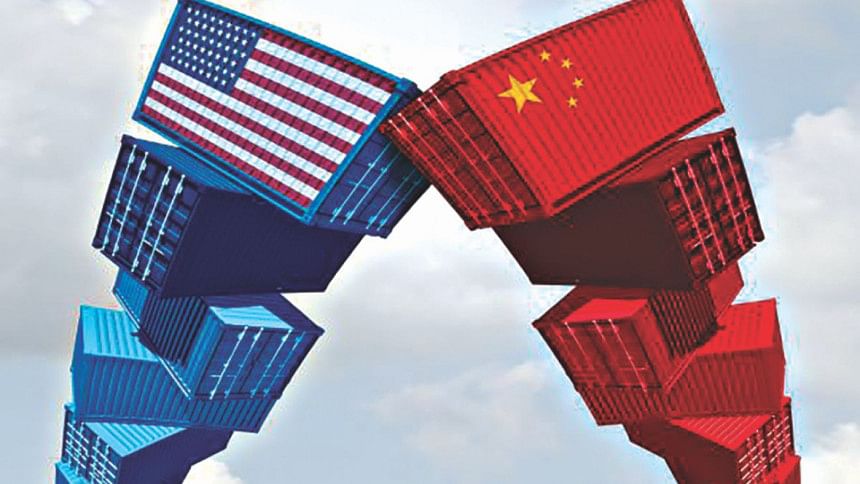What does the US-China trade war mean for Bangladesh?

Professor Shakhawat Ali Khan, a veteran journalism professor at Dhaka University, often invokes a Second World War-era story in his classes to make his students realise just how important international affairs is. When the war persisted, many Indians were faced with an increased price of some of their essential commodities. As they began to inquire, they were baffled to learn that the price hike was due to the war.
How could a war being fought in faraway places a farmer in India never heard of dictate the price of a material he very often used? "International affairs is more closely associated with your lives than you may have realised," Professor Khan would go on to say.
The latest demonstration of this contention has been US President Donald Trump's so-called trade war against his allies and foes which threatens to destabilise the global trade and order. And, unlike the previous global financial crisis, Trump's war will have far-reaching consequences for Bangladesh's trade and economy.
From a broader perspective, Trump's trade policy has been consistent with his protectionist worldview. On the third day of his presidency, he effectively sank the Trans-Pacific Partnership (TPP) deal, which would have given Vietnam, Bangladesh's major trade competitor, a considerable advantage in the American market. In that sense, it was a good thing for us, but the war he is currently waging against China is harder to predict.
The first impact of the war was first felt in Bangladesh's steel industry. For the last few months, the price of rod has significantly increased in the domestic market, threatening both the major public infrastructure projects—which the government wants hurriedly to make progress on in an election year—and the real estate market. With an unhappy response from the business community, the industry leaders came up with a number of reasons—the major one being, unsurprisingly, Trump's tariffs on steel and aluminium imports.
It may sound a bit confusing as to why a US import tariff would increase the cost of producing steel in Bangladesh, but it's simple if explained. To be precise, it's the side-effect, not the tariff itself, which affects us. Bangladesh imports scraps, a raw material for steel, mainly from the United States, also the major global exporter of scraps, but steel millers in the country are stockpiling the raw material anticipating more protectionist measures from the Trump administration, reducing supply and thus increasing the price. And it's not going to end here.
In response to Trump's 25 percent tariff on USD 34 billion worth of Chinese exports, China placed a reciprocal tariff on American exports—including soybean and cotton—to China worth the same amount. In a bid to find some alternatives elsewhere, China has decided to lower or cancel tariff on thousands of goods from Bangladesh, India and three other countries.
It seems like good news for us, but since China is primarily looking for an alternative to American soybean, Bangladesh will not be able to cash in on the crisis, since we import soybean—that too mainly from the US—rather than export, but a declining American soybean price should greatly help our consumers.
The Chinese tariffs on American cotton also caused a sudden fall in price, but America's market share of our cotton import is roughly above 20 percent. India provides more than half the amount of cotton we import, and as China looks forward to importing cotton from India, the price of Indian cotton has already increased by 10-12 percent, substantially hurting our economic lifeline, the readymade garment sector.
The Trump administration is poised to impose an additional 10 percent tariff on USD 200 billion worth of Chinese goods—roughly half the total US import from the country—but it is still unclear how many alternatives, if any, to Chinese goods we will be able to provide American consumers with. One should note that the Chinese goods being targeted by the latest US tariffs do not include most Chinese-made clothing.
China may not be able to hit back reciprocally when the latest announced tariff goes into effect because it actually imported USD 150 billion worth of goods from America last year in total. However, China could, in theory, impose a higher tariff to exert the same impact on the American economy. In that case, Trump could retaliate with further tariffs: the US imported Chinese goods worth USD 500 billion last year, meaning Trump still has ammunition amounting to USD 250 billion.
As tariffs on Chinese clothing would escalate price, America may lower existing tariffs on imports of clothing from Bangladesh and Vietnam. While this is unlikely, there's a good case as to why American administration should do so.
According to an April study by Pew Research Center, Bangladesh and Vietnam's clothes and shoes are subjected to disproportionately high rates of US taxes—the main exception to a common American practice of imposing low tariffs on large volume imports.
In fact, it is Bangladesh—followed by other low-income countries in South Asia—that is subjected to the highest US duties, equivalent to 15.2 percent of the total value of our exports to the country. Trump may want to end this unfair practice.
As long as Trump is up against China and other big countries, it is a zero-sum game for Bangladesh, but many in Bangladesh fear Trump's protectionist approach wouldn't be limited to big countries alone. What if, for instance, Trump imposes a blanket tariff on all RMG imports?
One of the major stated objectives of Trump's trade war is cutting down America's giant trade imbalance with China. He and his protectionist trade advisers seem to be upset about the fact that China has a trade surplus of over USD 350 billion with the US, and Trump wants it to be reduced by USD 200 billion. China, while rejecting the demand, quite correctly pointed out that the US' current account deficit was because of its persistently low savings rate relative to investment—which ironically is credited for a strong US economy. If the Trump administration could somehow force China to reduce its trade surplus with America, Jim O'Neil, the former chief economist at Goldman Sachs Group, points out, the surplus would simply be shifted to countries like Bangladesh and Vietnam if the US fails to raise its savings rate concurrently.
Nicholas R Lardy, a senior fellow at the Peterson Institute for International Economics, has a better explanation why. "In the best case, they might reduce imports from China by USD 30 billion, but it will have virtually no effect on the US global trade deficit," he told the Washington Post. "We'll just start buying things from the next lowest-cost supplier, such as Bangladesh or Vietnam. It's not that the USD 30 billion will magically be produced in the United States the day after they announce these tariffs."
But, since the trade war may prove politically damaging for the president in soybean- and cotton-producing red states, will Trump push too hard and too far? Mark Mobius, a well-respected American financial industry expert and investor, bets he will. "What I would buy now is those countries [that] are going to be exporting to the US instead of China—like Bangladesh, Turkey, Vietnam," he recently told CNBC. "These are all big producers of garments and shoes and consumer goods."
Nazmul Ahasan is a member of the editorial team at The Daily Star.





Comments